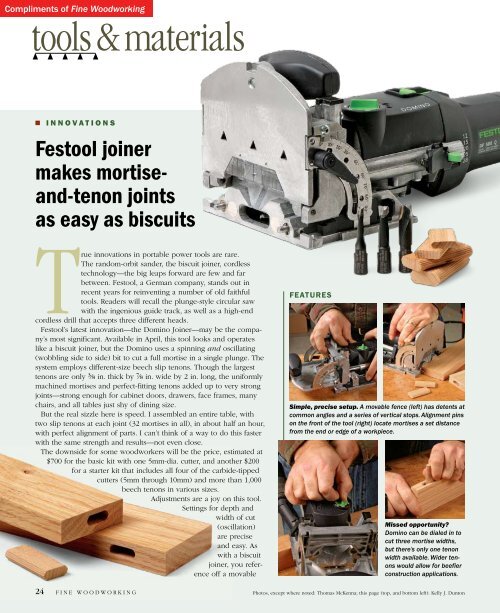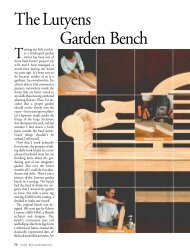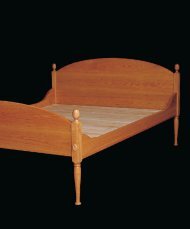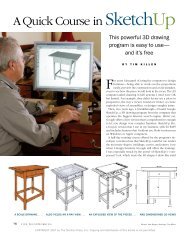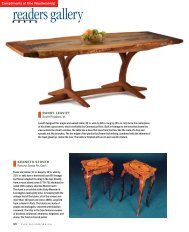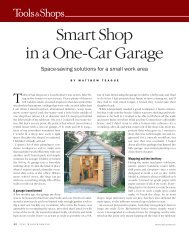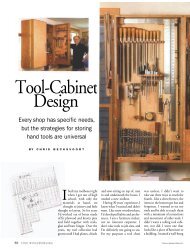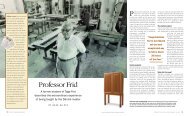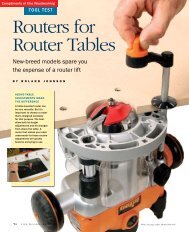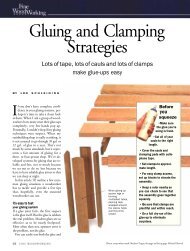You also want an ePaper? Increase the reach of your titles
YUMPU automatically turns print PDFs into web optimized ePapers that Google loves.
Compliments of <strong>Fine</strong> <strong>Woodworking</strong>tools & materials■i n n o v a t i o n sFestool joinermakes mortiseand-tenonjointsas easy as biscuitsTrue innovations in portable power tools are rare.The random-orbit sander, the biscuit joiner, cordlesstechnology—the big leaps forward are few and farbetween. Festool, a German company, stands out inrecent years for reinventing a number of old faithfultools. Readers will recall the plunge-style circular sawwith the ingenious guide track, as well as a high-endcordless drill that accepts three different heads.Festool’s latest innovation—the Domino Joiner—may be the company’smost significant. Available in April, this tool looks and operateslike a biscuit joiner, but the Domino uses a spinning and oscillating(wobbling side to side) bit to cut a full mortise in a single plunge. Thesystem employs different-size beech slip tenons. Though the largesttenons are only 3 ⁄8 in. thick by 7 ⁄8 in. wide by 2 in. long, the uniformlymachined mortises and perfect-fitting tenons added up to very strongjoints—strong enough for cabinet doors, drawers, face frames, manychairs, and all tables just shy of dining size.But the real sizzle here is speed. I assembled an entire table, withtwo slip tenons at each joint (32 mortises in all), in about half an hour,with perfect alignment of parts. I can’t think of a way to do this fasterwith the same strength and results—not even close.The downside for some woodworkers will be the price, estimated at$700 for the basic kit with one 5mm-dia. cutter, and another $200for a starter kit that includes all four of the carbide-tippedcutters (5mm through 10mm) and more than 1,000beech tenons in various sizes.Adjustments are a joy on this tool.Settings for depth andwidth of cut(oscillation)are preciseand easy. Aswith a biscuitjoiner, you referenceoff a movableFeaturesSimple, precise setup. A movable fence (left) has detents atcommon angles and a series of vertical stops. Alignment pinson the front of the tool (right) locate mortises a set distancefrom the end or edge of a workpiece.Missed opportunity?Domino can be dialed in tocut three mortise widths,but there’s only one tenonwidth available. Wider tenonswould allow for beefierconstruction applications.24 F I N E w o o d w o r k i n gPhotos, except where noted: Thomas McKenna; this page (top, and bottom left): Kelly J. Dunton
front fence to get different slotlocations and angles. The Festool’smovable fence is nicely designed, but wehad two problems with it. One of its pivotpins dropped out, and had to be reinsertedand tightened. Worse, though, part of theclamping mechanism broke. With lots ofpeople using the tool, we can’t say for surethat it wasn’t user error, but a close examinationof the break reveals a thin cast sectionthat must withstand considerable pressureif someone overtightens the fence. Festoolreplaced the front half of the machine, andthere have been no problems since. Bottomline: Don’t overtighten the clamp handles onthe fence; they don’t require much pressure.I have only two other quibbles with thetool. While it oscillates to three mortisewidths—up to 1 1 ⁄4 in. wide—tenons comeonly in the narrowest width. The extra roomeases assembly when the mortises are usedin rows, but Festool is missing an opportunityto provide more substantial tenons. Also,alignment pins in the front that reference offthe corner of a workpiece to make layoutunnecessary are too far from the edge of themortise for my liking, leaving room for twistat the corner of a frame, for example.Chairmakers will like the accessory thatsupports narrow parts to allow end-grainmortises at various angles.Dust collection is critical with this tool;the airflow keeps the motor cool and clearsthe chips so that the cutter doesn’t bind in adeep slot. Also, clamp the workpiece, holdthe unit down firmly, and let the tool cut.You’ll need to plunge slowly into the hardestwoods.Overall, the Domino is an impressive toolthat could change your woodworking. Formore information, visit www.festoolusa.com.—Asa Christiana is the editor.<strong>Fine</strong><strong>Woodworking</strong>.comWatch a video demonstration of the Domino Joinerand inspect its components up close.How to use the domino1Mark the center of the mortise. Aswith a biscuit joiner, these marks willguide the tool.2Set the depth of the cut. It shouldbe a bit deeper than half the tenonlength to allow for glue.3Hold steady and plunge slowly.Align the center mark on the fencewith the mark on the workpiece.4Insert the tenons and assemblethe joint. You’ll get a perfect fit inminutes.■A c c e s s o r i e ssave timewhen sandingWhen you shut off a typical random-orbitsander, you can’t put it down immediatelybecause it takes about 10 seconds to stopspinning. So you end up holding the sanderjust above the bench, and the 10 secondsseems more like 10 minutes. That is takencare of with the Orbital Station, a productdesigned to hold almost any random-orbitsander while it’s running or as it winds down.The Orbital Station is hardly high-tech,but it worked with a few different modelsof random-orbit sanders. Each one slippedinto the holder quickly and easily—evenAdjustable yoke holds most random-orbitsanders. The upper portion of the sander slipsinto the yoke while the bottom end of the sanderrests against a pair of rubber bumpers.while it was on—and it was just as easy toremove. The station also can hold a sanderthat’s attached to a vacuum hose. Thestainless-steel yoke can be manipulatedto accommodate several models of palmsanders and even laminate trimmers.The Orbital Station sells for $36 (plusshipping). For more information, call 413-625-6063 or go to www.orbitaltoolstation.com.—Tom Begnal is an associate editor.www.finewoodwor k i n g.comM a r c h / A p r i l 2 0 0 725
tools & materials continued■h a n d t o o l sWoodjoy shave leavesa flawless finish on end grainWhile generaluseshaves excel atcutting face grain, low-angle shaves excel at working endgrain. The new #85 spokeshave from Woodjoy falls into thelatter group.The Brazilian-cherry body is 12 in. long and has a 5 ⁄32-in.-thick, 2 1 ⁄2-in.-long, A2 steel blade and a brass sole. The blade is hollow-ground on thebottom, making it easy to flatten and sharpen. When razor-sharp, the lowangleblade will leave a slick finish on the end grain of even the softestwoods, including white pine.Cutting depth is adjusted bymoving the sole; the mouthopening by moving the blade.The sole and the blade havecountersunk slots for the screwsthat secure them to the body. Ifound that because of this, bothmove slightly off their settingswhen the screws are tightened,making adjustments tricky. The#85 costs $95 and is availablefrom www.woodjoytools.com.—Curtis Buchanan is achairmaker in Tennessee.Easy sailing on end grain. The Woodjoy lowangleshave leaves a smooth surface in its wake.■s h o p s o l u t i o n sGIVE MACHINES A LIFTessentially a mobile base, General’sHoverpad floats a machine on a 1 ⁄8-in. to1⁄2-in. cushion of air. It comes in two sizes—18 in. by 24 in. (model 10-824, $165) and29 in. by 29 in. (model 10-929, $265)—with allthe necessary fittings to attach to a compressor.The smaller model is rated to lift up to 600 lb.;the larger, up to 1,200 lb. A 500-lb. load willneed between 2.5 cfm and 3.5 cfm at about90 psi, while heavier loads require 5 cfm to6 cfm at around 120 psi. We tried the 29-in.-sq.model, using it to move a floor-standing hollowchiselmortiser that weighs about 360 lb.In areas where our shop floor was smoothsemigloss paint, the Hoverpad worked great.In areas where the floor was rough or pitted,the Hoverpad did not work. General says thepad requires a hard, airtight floor surface andrecommends you do a suction-cup test beforebuying. If the suction cup sticks to the floor,even slightly, the Hoverpad will fly. If it doesn’tstick, you’ll need to treat or cover the floor insome way to make a suitable, airtight runway.For more information, visit www.general.ca.—T.B.■A c c e s s o r i e sTurn on tool andvacuum simultaneouslyThe i-socket switch is an adapter that turns on ashop vacuum or dust collector automatically whena tool is fired up. Simply plug the i-socket into a15-amp/125v outlet, then plug the tool and vacuuminto their designated slots, making sure the vacuumswitch is in the on position. When you turn on thetool, the vacuum will run; turn off the tool, and thevacuum shuts down after a 7-second delay to clearout the hose. The i-socket sells for $34 and is availablefrom www.woodcraft.com.—Tom McKenna is an associate editor.Clear for takeoff. Quick-connect fittings connectthe pad to the compressor. Place the machineon the pad and fire up the compressor. In seconds,the machine levitates on a cushion of air.26F I N E w o o d w o r k i n g
www.finewoodwor k i n g.com M a r c h / A p r i l 2 0 0 727


